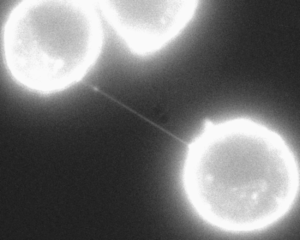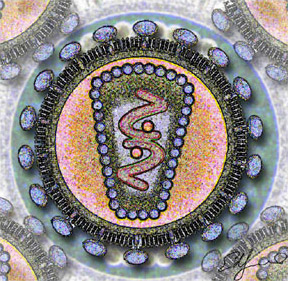 Several posts have documented the unusual complex behavior of viruses. In particular, a recent post, The Remarkable Intelligent Varicella Virus, described a wide range of different complex behaviors for this small herpes virus. Somehow, it is able to enter and exit skin and nerve cells; travel up and down along the microtubules of the axons by commandeering the motors; move in and out of the cell’s nucleus; and alter its own behavior in different circumstances. The varicella virus has more than 70 genes to provide the basis of this unusual activity. With such a small “genetic brain,” how can it know how to do this?
Several posts have documented the unusual complex behavior of viruses. In particular, a recent post, The Remarkable Intelligent Varicella Virus, described a wide range of different complex behaviors for this small herpes virus. Somehow, it is able to enter and exit skin and nerve cells; travel up and down along the microtubules of the axons by commandeering the motors; move in and out of the cell’s nucleus; and alter its own behavior in different circumstances. The varicella virus has more than 70 genes to provide the basis of this unusual activity. With such a small “genetic brain,” how can it know how to do this?
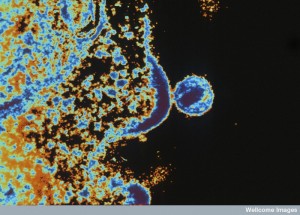 Even more remarkable, however, is the genetically much smaller HIV virus, with only 9 genes that, also, demonstrates extremely complex behavior. It is able to invade the vastly more complex human immune cells that are primed to destroy it (see post, The Intelligent T cell). With just 19 proteins, it is able to enter the cell; evade sensors that trigger the devastating interferon; evade multiple toxins stimulated by interferon; make double stranded DNA from its RNA genome; reach into the cell’s nucleus while hiding its activity; and place the viral DNA in the genome of the human cell. From this vantage point it can stay quiet, make more viruses, or kill the cell it is in, as well as other cells nearby. It is able to transfer itself between multiple cells in different ways, and very remarkably, can kill other cells without entering them. The very complex reassembly at the cell’s membrane includes the many parts of a newly created virus, before it is released again as a free virus. It is able to counter many attacks of the vastly more complex human cells.
Even more remarkable, however, is the genetically much smaller HIV virus, with only 9 genes that, also, demonstrates extremely complex behavior. It is able to invade the vastly more complex human immune cells that are primed to destroy it (see post, The Intelligent T cell). With just 19 proteins, it is able to enter the cell; evade sensors that trigger the devastating interferon; evade multiple toxins stimulated by interferon; make double stranded DNA from its RNA genome; reach into the cell’s nucleus while hiding its activity; and place the viral DNA in the genome of the human cell. From this vantage point it can stay quiet, make more viruses, or kill the cell it is in, as well as other cells nearby. It is able to transfer itself between multiple cells in different ways, and very remarkably, can kill other cells without entering them. The very complex reassembly at the cell’s membrane includes the many parts of a newly created virus, before it is released again as a free virus. It is able to counter many attacks of the vastly more complex human cells.
Although an enormous amount of research has been done on HIV, still, much is not known about the incredibly adaptive HIV virus. But, it is now clear that this very clever virus is able to escape the immune system by directly invading the most intelligent immune cells. By attacking the immune system directly, it weakens the entire body. It is able to travel in and out of cells that should be able to kill it. It is quite remarkable what HIV can do with such a small “genetic brain”. Because of the small number of genes in HIV, it has become a master of evasion, rather than emphasizing specific attacks against the factors that the cell sends its way. But, HIV still faces and antagonizes some specific immune molecules.
This post will outline the complex lifestyle of the HIV virus and the particular ways it outwits our most intelligent and complex cells.
HIV Structure
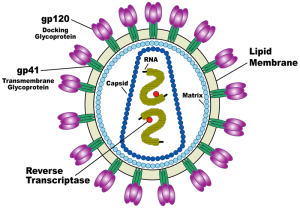 Each HIV virus has two strands of RNA with 9 different genes. Even though HIV has a small number of genes, it is actually a physically large spherical virus with many different layers of protein covers and active enzymes embedded in a matrix; it is 60 times smaller than a red blood cell. The two copies of RNA are tightly packaged and surrounded by a protein capsid that is in the shape of a cone, made up of 2000 copies of a protein from the virus’ genes.
Each HIV virus has two strands of RNA with 9 different genes. Even though HIV has a small number of genes, it is actually a physically large spherical virus with many different layers of protein covers and active enzymes embedded in a matrix; it is 60 times smaller than a red blood cell. The two copies of RNA are tightly packaged and surrounded by a protein capsid that is in the shape of a cone, made up of 2000 copies of a protein from the virus’ genes.
The RNA is bound by structural proteins, as well as copies of the four critical enzymes that the virus carries with it. The RNA can take different shapes, for action and compressed for traveling in tight quarters. It can produce more of its enzymes when it can use the machinery of the cell. The four proteins that are carried in the virus include the 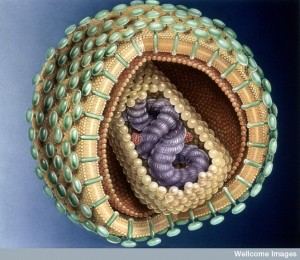 very important reverse transcriptase, which takes the RNA and reverse transcribes it into DNA. It, also, includes a s protease, ribonuclease and integrase enzymes that help it sneak into the nucleus and sew itself into the cell’s genome. Yet another protein layer surrounds the capsid to make the round large shape.
very important reverse transcriptase, which takes the RNA and reverse transcribes it into DNA. It, also, includes a s protease, ribonuclease and integrase enzymes that help it sneak into the nucleus and sew itself into the cell’s genome. Yet another protein layer surrounds the capsid to make the round large shape.
Another covering layer, the viral envelope, is made of phospholipids, which are stolen from the cell membrane as it buds out of the cell. About 70 special large complex proteins sticks through the surface of the virus, which helps the virus latch onto the next cell it encounters.
Nine Genes in the HIV RNA Strand

The nine genes make 19 different proteins through editing of the messenger RNA. Three genes make the structural proteins. Six others make proteins that allow the virus to make copies of itself — those that allow the virus to enter cells and the nucleus, and others to sew the DNA into the human genes.
One of the genes makes microRNA that interacts with the genes of the cell and can cause cell death. Another protein helps get newly created RNA from the nucleus to the outer cell membrane to make a new virus. One gene can stop the cell’s ability to reproduce and another interferes with cell’s ability to grab the virus. A special gene helps the pieces of virus use the cell’s membrane to bud from the cell and release itself from the cell into the blood. A section at the end of repeated RNA, that is not a gene, contains switches to help make new viruses
HIV Attacks Immune Cells
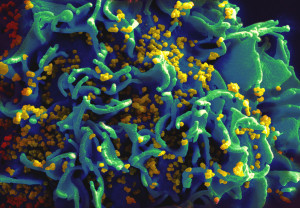 HIV attacks a variety of different immune cells, and is able to behave differently in each—CD4+T cells, macrophages, dendritic cells, and the microglia in the brain. The virus has different techniques for entering each cell—with T cells and macrophages it uses specific glycoproteins and cytokine co receptors.
HIV attacks a variety of different immune cells, and is able to behave differently in each—CD4+T cells, macrophages, dendritic cells, and the microglia in the brain. The virus has different techniques for entering each cell—with T cells and macrophages it uses specific glycoproteins and cytokine co receptors.
Macrophages are, often, the first cells attacked by HIV and are, perhaps, the major cell where they live in quiet reservoirs after large numbers of T cells are killed. In lymph tissue such as tonsils, HIV lives in giant cells formed by fusion of many macrophages and these cells produce very large amounts of virus. In the brain macrophages and microglia are the target cells.
T4 cells are the critical helper cells that direct the immune process. HIV attacks, infects and kills T4 cells the most. T8 cells are the cells that target and kill infected cells. Usually T4 cells stimulate T8 cells to fight infected cells. Strangely, T8 cells help in killing the infected T4 cells that stimulate the T8 to action. Somehow, HIV also, damages T8 cells without entering them, making them less effective. HIV damages two critical factors in T8 cells that impair their memory and their ability to grow.
Entry to Into Cell

The mechanism by which HIV enters the cell is not simple. It involves interaction of special proteins on the surface of the virus and receptors on the immune cell. The virus protein has to alter its shape, which allows it to go through the cell’s membrane and then another shape change occurs, this one involving folding in half and forming coils that twist together. This complex process joins the cell’s membrane and the membrane of the virus.

With macrophages and T cells, an elaborate process occurs where the glycoproteins on the surface of the virus fuse the cell membrane to the outer layer of the virus (envelop) and then the capsid is sent into the cell. This process uses a large molecular complex on the envelope to join with a cytokine receptor on the cell. A special synapse of the virus and the receptor occurs using the molecule integrin. This same process, also, allows the virus to spread to other cells.
As soon as the virus is bound to the cell, it then injects contents into the cell including the four enzymes it is carrying and its RNA. The virus then uses the microtubules to transport itself near the nucleus where it makes the double stranded DNA from the RNA using its own enzymes.
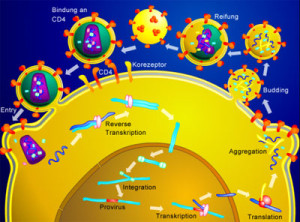
With the capsid in the cell, the reverse transcriptase enzyme extricates the RNA from the protein matrix which has been holding it in place until this point. From the virus RNA, it makes a strand of the complementary antisense DNA, and then it copies the antisense DNA to make the second regular sense DNA to form double stranded DNA. Also, like human DNA, these two different strands can recombine in different ways allowing more diversity.
The process which makes DNA produces many errors that allows for mutations, often causing drug resistance or other new qualities including the ways it evades the immune system, discussed below. The same enzyme, also, destroys the RNA after the DNA is made. Then, the double stranded DNA is transported through the nuclear pore by the viral enzymes and another enzyme sews it into the genome.
Sitting Quietly in T4 cells

When the viral DNA is in the T4 cell’s genome, the cell can become quiet or make copies. If the T cell stays quiet, the HIV genes stay as a reservoir for the future. There are special cellular factors that normally activate T cells, such as NF kappaB. It is strange that the very activation of T4 cells that should fight HIV, in fact, stimulates the cell to make more copies of the virus from the T4 cell’s DNA. Unfortunately, this means that the very cells that are activated to fight HIV are making more viruses and eventually kill the T cell
The HIV lying in the genes of non-active memory CD4+T cells is thought to be a source of long lasting infection. Recently, it was found that HIV stimulates these T cells to multiply, producing a larger reservoir of HIV infection.
The exact locations in the human genome where the viral DNA is placed are, often, where the cell’s DNA is most active. The viral DNA sits right with the genes for the T cell’s reproduction factory and possibly where cancer is stimulated. The HIV genes can, therefore, promote cell reproduction, which provides a bigger long-term reservoir of HIV infected cells, ready to make more HIV at some point.
HIV Can Travel From Cell to Cell
Once inside the T4 cell, HIV has many different ways to get from one cell to another.

From Ayacop One way involves synapses between immune cells, where HIV passes through to the other cell. These synapses use special adhesion molecules to hold the cells together. The synapse can involve many cells. HIV triggers these synapses and virus transfers within an hour.
- Another route is through nanotubes (called cytonemes – see picture) between cells.
- When quiet T cells with HIV in the DNA are activated they produce more virus.
- Another transfer is when dendritic cells present antigen to T cells, the virus jumps from one cell to the other.
- HIV is, also, transferred in sacs.
HIV Makes Messenger RNA and New Viruses
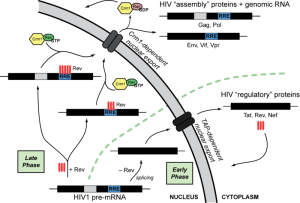
The viral DNA embedded in the host cell, at first makes messenger RNA, which is spliced into small pieces. The small proteins made from this spliced RNA accumulate and attach to the messengerRNA. The attachment of these small proteins stops the splicing process and allows the entire HIV genome to copied at once. This full copy of the HIV RNA genome is, then, used to assemble a new virus, packaged with all its layers of coats and compacted enzymes for traveling.
The final creation of the new virus occurs at the cell’s membrane. The full assembly then buds 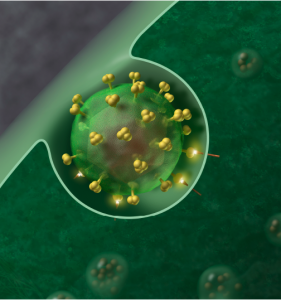 from the membrane as a full virus outside of the cell. For this assembly process, a special viral protein goes into the cell’s endoplasmic reticulum (ER) and then the Golgi complex, the usual places that the cells make complex proteins and other molecules. This protein is cut in half, creating the two critical glycoproteins for the envelop of the virus.
from the membrane as a full virus outside of the cell. For this assembly process, a special viral protein goes into the cell’s endoplasmic reticulum (ER) and then the Golgi complex, the usual places that the cells make complex proteins and other molecules. This protein is cut in half, creating the two critical glycoproteins for the envelop of the virus.
From the ER and Golgi, the glycoproteins are transported near the membrane where they are joined inside of the cell’s membrane along with the new viral RNA genome. Both are connected together, along with the copies of the four important enzymes, and the entire package is pushed out the membrane as a budding virus. The virus steals the cell’s membrane itself as the final coating.
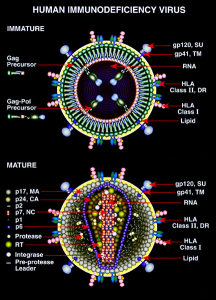 This budding process is very complex and involves special cutting of the viral proteins forming the matrix that becomes the capsid and other proteins that hold the various enzymes in place. This cutting is done by the viral protein protease (these are the focus of protease inhibitors used to fight AIDS). All of these pieces then combine and are covered by the cell’s membrane, which forms the outer layer of the virus by budding. The virus is then released.
This budding process is very complex and involves special cutting of the viral proteins forming the matrix that becomes the capsid and other proteins that hold the various enzymes in place. This cutting is done by the viral protein protease (these are the focus of protease inhibitors used to fight AIDS). All of these pieces then combine and are covered by the cell’s membrane, which forms the outer layer of the virus by budding. The virus is then released.
It is quite remarkable that all of this can be accomplished with only 9 viral genes. But, HIV’s unusual behavior doesn’t stop there. As well as this extremely complex multi step process, the virus is, also, able to maneuver to evade the sensors and attack molecules that are aimed to destroy the entire process.
Intelligent Evasion of the Immune Cells
 The immune cells are perhaps the most complex and intelligent cells in our bodies. For a description of just how incredible their function is see the posts: T Cells Are Critical for Cognition, the Intelligent T cell, Are Microglia the Most Intelligent Brain Cells, and Intelligent Platelets.
The immune cells are perhaps the most complex and intelligent cells in our bodies. For a description of just how incredible their function is see the posts: T Cells Are Critical for Cognition, the Intelligent T cell, Are Microglia the Most Intelligent Brain Cells, and Intelligent Platelets.
But, despite the extremely complex function of these immune cells—T cells, dendritic cells, macrophages, and microglia—these are exactly the cells that the tiny HIV virus outwits. How they can do this with 9 genes is an amazing story.
Immune Cells Defend Against HIV
 The innate immune system evolved to defend against viruses by identifying them and then attacking with specific molecules. In this process, the slower adaptive immune system is informed of the exact nature of the invader to prepare more elaborate responses using T cells and antibodies.
The innate immune system evolved to defend against viruses by identifying them and then attacking with specific molecules. In this process, the slower adaptive immune system is informed of the exact nature of the invader to prepare more elaborate responses using T cells and antibodies.
Receptors on immune cells pick up the molecular patterns of HIV invaders. One type of receptor is a large molecule that lies across the membrane and picks up intruders before they enter the cell. There are other receptors inside the cells that pick up the presence of naked DNA and RNA floating in the cytoplasm.
The receptors trigger signals to the cell nucleus stimulating gene networks that produce cytokines—such as the powerful interferon. Interferon triggers production of hundreds of different proteins that fight the virus and warn other cells to resist and fight. However, the large number of genes stimulated and products made by interferon makes it hard to study.

Although HIV is considered very infectious, in fact, it takes on average 100 exposures for the HIV to take hold. It is HIV’s ability to avoid triggering sensors and interferon that finally determines whether the infection will occur. Different mutations in HIV affect the sensitivity to interferon and the many factors that interferon stimulates.
As cells are infected with HIV, it kills more T4 cells than macrophages. Most new HIV is manufactured in T4 cells, but strangely, HIV can reproduce in macrophages without much cytokine signaling and little cell death. It is not yet clear what the overall importance of reproduction in dendritic cells and macrophages are. HIV behaves differently in each cell type because in each it attracts different co factors to evade the sensors and interferon.
Since the virus needs to take over the cell’s nucleus to operate, many of the cell’s defensive measures stop the virus from entering the nucleus. The defensive measures, also, protect against new viruses created near the cells membrane before they escape. The cell sometimes takes an extreme measure of the suicide response, called apoptosis, where the cell kills itself to kill the viruses.
HIV Evades Cellular Receptors
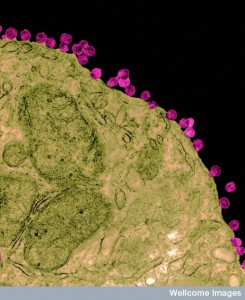 Ordinarily, the cellular mechanism translates DNA code into RNA code. HIV is called a retrovirus because its RNA is transcribed in reverse into double stranded DNA in the cytoplasm, not the nucleus. When the cell senses any DNA in the cytoplasm, special sensors produce the powerful interferon.
Ordinarily, the cellular mechanism translates DNA code into RNA code. HIV is called a retrovirus because its RNA is transcribed in reverse into double stranded DNA in the cytoplasm, not the nucleus. When the cell senses any DNA in the cytoplasm, special sensors produce the powerful interferon.
But, HIV has developed special techniques to avoid these sensors called cloaking. HIV is able to use a variety of special co factors that can allow the virus to evade the sensors. One of these critical co factors is an enzyme in the endoplasmic reticulum that allows the virus to make the viral DNA. This enzyme usually would cut up HIV DNA in the cytoplasm, but the enzyme is maniupulated by HIV to do the exact opposite—increasing HIV actions.
HIV Cloaking in Macrophages
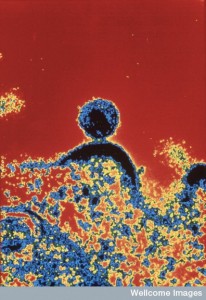 HIV has developed other cloaking techniques.
HIV has developed other cloaking techniques.
When the covering of the HIV enters the cell, it attracts two co factors from the cell. The first is an enzyme, which alters parts of the virus cover. The second is a nuclear protein involved in messenger RNA that helps HIV enter the nucleus. This process hides specific motifs on the HIV surface that sensors would pick up. These two factors allow HIV to reproduce in immune macrophages (monocytes). These two factors in interaction with the virus are able to stop the production of the powerful interferon.
There are a variety of other unique evasion techniques.
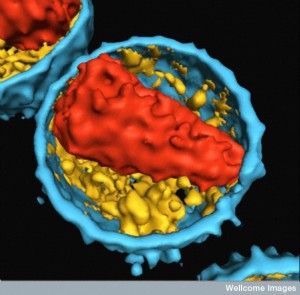 One involves the unique un-coating process. The cone shaped capsid houses the complex of molecules that produces the reverse transcription. This protein cone cover must first come off before the RNA can be used to make DNA. HIV has developed a special, very complex, way that the coat comes off that hides the DNA from the sensors.
One involves the unique un-coating process. The cone shaped capsid houses the complex of molecules that produces the reverse transcription. This protein cone cover must first come off before the RNA can be used to make DNA. HIV has developed a special, very complex, way that the coat comes off that hides the DNA from the sensors.
This very detailed process involves the nuclear pore molecules. Strangely, from the cytoplasm, HIV is able to have interactions with complex molecules inside of the nuclear membrane. A viral molecule reaches into the nucleus through a pore, and this helps to un-coat the HIV virus. With this connection from the cytoplasm to the nucleus, the DNA can be sent directly into the nucleus and not meet any cytoplasm sensors. Because the nucleus is the place the cell understands DNA to be, the same sensors don’t pick up the viral DNA once it is in the nucleus. In this process, the DNA from the HIV can be taken into the genome of the cell.
Interferon Makes Restriction Factors To Fight HIV
The cytokine interferon works by stimulating special proteins that are called “restriction factors.”
 In a previous post, the cell’s very complex ubiquitin process was described. Ubiquitin is a system of placing different chemical tags on molecules that alter their actions. This post described how microbes and cells actually wage war thought tagging and re tagging each other’s attack molecules in various complex ways.
In a previous post, the cell’s very complex ubiquitin process was described. Ubiquitin is a system of placing different chemical tags on molecules that alter their actions. This post described how microbes and cells actually wage war thought tagging and re tagging each other’s attack molecules in various complex ways.
With only 9 genes, HIV has, somehow, learned to use the ubiquitin machinery to mark the “restriction factors” created by interferon to kill the virus. Marking them alters their functions or leads to their destruction.
One restriction factor that stops HIV is tetherin, which lies in the cell’s membrane and “tethers” HIV to it. With tetherin, HIV is stopped from budding through the membrane to get out of the cell. Tetherin is also able to send signals to other cells to warn of the infection, where interferon can be triggered even before the virus gets there. Antogonizing tetherin is therefore very critical.

The most infectious strain of HIV is able to tag tethrin with ubiquitin, making it useless. This tagging has been a critical evolutionary development that makes HIV more infectious.
HIV is able to attract the ubiquitin tags to counter a variety of other cellular attacks.
- One mechanism for the cell to stop HIV is to inhibit the DNA synthesis. Another unusual technique is when the cell forces HIV to hyper mutate HIV DNA, so that it will become useless. Powerful enzymes from the cell that accomplish both of these are tagged by HIV.
- In another technique, a factor that uses ubiquitin is able to sense HIV, and then attract factors that block HIV DNA and take apart the virus. HIV is able to become invisible to the cell’s use of ubiquitin, escaping the destructive activity.
- Another cellular attack is a factor in T cells and dendritic cells that reduces the amount of materials (nucleotides) available to make DNA in the cytoplasm. This stops HIV from reproducing. In this case, HIV is able to mutate its DNA transcribing enzyme to function with a reduced amount of material.
HIV just doesn’t have enough genes to antagonize all of the restriction factors stimulated by IFN, so it uses these evasion techniques.
Outwitting Attacks and Spreading to Other Cells
HIV often kills T4 cells, which greatly weakens the immune system and allows HIV to spread. HIV can kill cells in different ways. It can directly kill them from inside. It can stimulate CD8 T cells to kill their own comrade T4 cells.
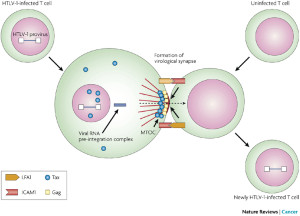 But, perhaps, the most unusual way has just been discovered. HIV can kill nearby T cells without even infecting them.
But, perhaps, the most unusual way has just been discovered. HIV can kill nearby T cells without even infecting them.
New information shows that HIV is quiet in a group of memory T cells and HIV is able to kill cells that are nearby these infected cells, without entering or infecting them. The process involves activation of specific caspase signals, where the virus fuses with the two cells—the infected and uninfected cells. When immune cells are connected in a synapse, the infected cell secretes a cytokine IL-1beta after cleavage by the caspase enzyme.
Two ways that caspase is triggered by HIV are sensing incomplete HIV products of reverse transcription and sensing damaged DNA. Abnormal HIV pieces of DNA trigger enzymes involved in DNA damage, which stimulates the cell’s suicide.
In both situations, the immune system itself is triggering T cell death from trickery by HIV.
The Very Intelligent HIV Virus
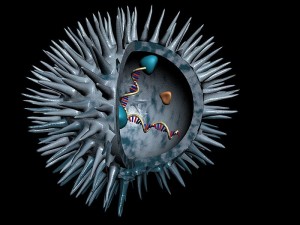 Despite having only 9 genes, HIV has a remarkable complex lifestyle. It carries its four essential enzymes when it travels, to be able to immediately transcribe its RNA into double stranded DNA. These proteins and the RNA are specially compacted into the cone shaped covering for efficient packaging to keep the virus small and round for better traveling.
Despite having only 9 genes, HIV has a remarkable complex lifestyle. It carries its four essential enzymes when it travels, to be able to immediately transcribe its RNA into double stranded DNA. These proteins and the RNA are specially compacted into the cone shaped covering for efficient packaging to keep the virus small and round for better traveling.
HIV outwits the cellular sensors; it evades the effects of the powerful interferon; it tricks the cell into letting it into the nucleus; it attracts co-factors that allow it to hide its reach into the nucleus; it stops the splicing of its RNA genome; it tricks the cell into letting it assemble new viruses at the membrane; it manipulates the endoplasmic reticulum and Golgi; and is able to match and outwit the cell’s use of ubiquitin tags. The re assembly process near the membrane is extremely complex, including a further cellular insult of taking pieces of the cell’s membrane for its own new cover.
Consisting, basically, of a small piece of RNA with several associated proteins, how can the very intelligent HIV virus have such a complex life?
